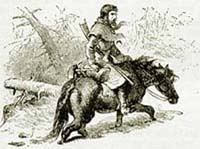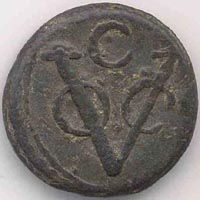Errors
The Horn Papers
Trusting Local AftifactsLocal history has its attractions, among them the pleasure of rescuing little things from oblivion. There is also a seeming freedom from the distortions of national agenda. Your grandfather's letters, discovered in a dusty trunk in your mother's attic: what could be the problem? National traditions may indeed often be corrected by local traditions, and presidential speeches may be clarified by humble reminiscences. Jang Sywe-chvng formed his theory of history in part from experience gained in writing and reflecting on local history. Local history has intrinsic virtue; it has genuine theoretical importance.
Alas for our comfort, it happens that mischief can crop up even in the village. As a sample of the dangers of trusting local documents (or any other documents), we cite here the case of the Horn Papers, from the peaceful western Pennsylvania countryside in the Depression year of 1932.
The Plot
To the editors of two newspapers in that countryside, W F Horn wrote in 1932 from Topeka Kansas (a city to inspire confidence, if there ever was one) concerning some papers and artifacts in his possession: diaries, maps, descriptions, the docket of what would have been the first court ever held west of the Alleghenies. One of the newspapers wound up printing some of the material, and so great was the local pride which those extracts aroused that the other newspaper joined in printing further instalments. They became a regular Sunday feature. W F Horn himself turned up, and became something of a local celebrity. He was invited to supervise local archaeological excavations; he lectured in Hagerstown on the history of Colonial Maryland. These audiences, to whom he also showed physical relics and 18th-century coins, he held spell-bound. Said a Marion County Historical Society official, Horn "could give dates, day, month, and year on which pioneers from whom our members are descended had come into this section." His material located known but lost early settlements. It filled gaps in the biographies of the great leaders of the westward migrations: Christopher Gist, John Canon, Thomas Cresap. Most of the families in the area traced their ancestry back to those first migrations. Local pride swelled.
The Horn documents and Mr Horn's lectures also attracted a certain amount of adverse comment. Asked why the massacre of 12,000 Indians at the Battle of Flint Top in 1748 was mentioned in no other early history, Horn referred doubters to "Andrea's History of Northwest Virginia," a volume of which no copy could be found, and whose existence could not be verified by extensive bibliographic searching. Still, perhaps it was merely excessively rare, as were so many early historical publications. But what about the alleged planting of three French lead plates in Greene and Montgomery Counties in 1751? Those doubts were all but silenced when two lead plates dated 1795 were excavated in August 1936, "just where the maps in the Horn Papers had indicated they would be found." The numbers did not match, the dates did not match, but that would get fixed. Mr Horn presently reported the discovery of an original 1751 plate with its French inscription. It had been found among the effects of a deceased sister.
This confirmation silenced the opposition, and the Greene County Historical Society swung into action. The President of the Society, A L Moredock, and its leading member, J L Fulton, shouldered the burden of arranging for publication of the Horn material. The University of Pittsburgh turned down the project, due to the prohibitive costs of verification. A New York commercial publisher agreed to accept the volumes, if the Society would edit them and subsidize the cost of publication. The raising of funds and the editing of the material were both problematic. The size of the material both grew and diminished during the process, as Mr Horn found more documents, but also borrowed some previously donated pages and did not return them. Moredock and Fulton knew nothing of the art of editing, and the original papers, copied onto sheets of every color and description, would have challenged the skills of professionals. They and their colleagues worked out ad hoc procedures. They boned up on their own history and that of adjacent regions. Above all, they steeled themselves to ignore the problems which emerged from the manuscripts as they were closely examined. But subscriptions had been solicited, and no directly adverse evidence had been found. The Society felt committed. After truly heroic efforts, $20,000, a princely sum for those hard times, was collected, much of it from Moredock and Fulton themselves. Wartime paper shortages were surmounted. And in the words of Middleton and Adair, "Mr Moredock and Mr Fulton saw with pride the three impressive volumes of The Horn Papers issue from the press in December 1945."
The Trial
The publication of the papers brought them to the notice of scholars, and accusations of fraud soon followed. Julian Boyd, Librarian of Princeton, wrote in the American Historical Review (July 1946): "I think the conclusion is inescapable that large parts of the documentary materials . . . are sheer fabrications."
A professional committee was formed to investigate. On examination, the papers were soon found to be fraudulent. Among the tests they failed, which in the bygone days of the discipline of history were familiar to any historian, were the following: (1) anachronistic and pseudo-archaistic words and phrases, (2) anachronistic use of the Gregorian rather than the Julian calendar, (3) biographical anomalies, such as anecdotes of Christopher Gist up to 1769, when Christopher Gist is unimpeachably known to have died in 1759, (3) internal contradictions and discrepancies in the documents, such as different dates given for the Battle of Flint Top, and (4) suspicious similarities of style between documents purporting to be of different authorship. Further, (5) the problem that supporting sources could not be located, already noted in Mr Horn's presentations to enthralled audiences, was also massively present in Mr Horn's documents. The committee were not enthralled. They concluded that the documents were attempting to conceal their sources.
Could anything be saved from this nightmare? Was any of the stuff reliable? In a second phase of its investigation, the committee took up this question. They found that only two of the documents claimed to be originals rather than Mr Horn's copies from the "moth-eaten" originals. One of these vanished during the investigation. The other, the court docket, together with three maps, were subjected to laboratory analysis. The result was crushing:
- The document and maps were not from 1760-1800 as claimed, but much later
- One person produced all the items examined
- The ink used in the documents showed they were written no earlier than 1930
Or, just in time to be mentioned to the editors of the two Washington County newspapers. The whole edifice, at first thought to be unimpeachable and massively self-supporting, simply collapsed. The good people of Washington County had been had. The lead in the French plates was indeed lead, but lead with a high nickel content, such as was geologically unknown in western Pennsylvania, and was known from only one locality, namely Missouri. It would have been available to an enterprising resident of Topeka around 1930, but not to anyone in western Pennsylvania in the 18th century. As a finale, the coin showed by Mr Horn at his Hagerstown lecture, and presented to his hosts at its conclusion, was indeed old. But it was not from the Colony of Virginia (COV). It was a Dutch duit (an eighth of a stuiver) bearing the VOC monogram common to all Dutch coins of that period. It was dated 1734.
Whereas the Virginia statute which first authorized the issuing of coins was passed in 1773.
All this is especially outrageous because was perpetrated, and succeeded, at the village level. It is as though your sister had died from eating a poisoned hotdog at the church supper. This story hurts. We mean it to hurt. We mean it to be memorable. The moral is this: Don't get suckered. Don't swallow everything people hand you. Test your hotdog on a live dog, before committing yourself. Or your sister. Or your family's reputation.
Readings
The whole Horn Papers story was printed in the first of the items mentioned below, and is reprinted in abridged form in the second, along with many other edifying examples of the perils of naive history. The third item is included merely for its value as a tragic artifact of misplaced historical trust:
- Arthur Pierce Middleton and Douglass Adair. The Mystery of the Horn Papers. William and Mary Quarterly 3ser v4 (October 1947) 409-443.
- Robin Winks (ed). The Historian as Detective: Essays on Evidence. Harper 1968
- A L Moredock and J L Fulton (ed). The Horn Papers: Early Westward Movement on the Monongahela and Upper Ohio, 1765-1795. Committee for the Greene County Historical Society, 3v 1945
Twenty. Thousand. Dollars. The poor fools.
15 June 2004 / Contact The Project / Exit to Home Page

